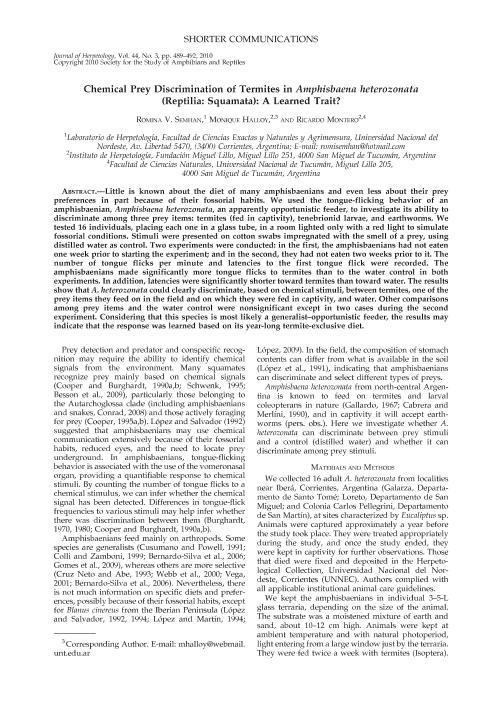Artículo
Chemical prey discrimination of termites in Amphisbaena heterozonata (Reptilia: Squamata): A learned trait?
Fecha de publicación:
09/2010
Editorial:
Society for the Study of Amphibians and Reptiles
Revista:
Journal of Herpetology
ISSN:
0022-1511
Idioma:
Inglés
Tipo de recurso:
Artículo publicado
Clasificación temática:
Resumen
Little is known about the diet of many amphisbaenians and even less about their prey preferences in part because of their fossorial habits. We used the tongue-flicking behavior of an amphisbaenian, Amphisbaena heterozonata, an apparently opportunistic feeder, to investigate its ability to discriminate among three prey items: termites (fed in captivity), tenebrionid larvae, and earthworms. We tested 16 individuals, placing each one in a glass tube, in a room lighted only with a red light to simulate fossorial conditions. Stimuli were presented on cotton swabs impregnated with the smell of a prey, using distilled water as control. Two experiments were conducted: in the first, the amphisbaenians had not eaten one week prior to starting the experiment; and in the second, they had not eaten two weeks prior to it. The number of tongue flicks per minute and latencies to the first tongue flick were recorded. The amphisbaenians made significantly more tongue flicks to termites than to the water control in both experiments. In addition, latencies were significantly shorter toward termites than toward water. The results show that A. heterozonata could clearly discriminate, based on chemical stimuli, between termites, one of the prey items they feed on in the field and on which they were fed in captivity, and water. Other comparisons among prey items and the water control were nonsignificant except in two cases during the second experiment. Considering that this species is most likely a generalist-opportunistic feeder, the results may indicate that the response was learned based on its year-long termite-exclusive diet.
Palabras clave:
Amphisbaena Heterozonata
,
Chemical Signals
,
Termites
,
Prey Discrimination
Archivos asociados
Licencia
Identificadores
Colecciones
Articulos(CCT - NOA SUR)
Articulos de CTRO.CIENTIFICO TECNOL.CONICET - NOA SUR
Articulos de CTRO.CIENTIFICO TECNOL.CONICET - NOA SUR
Citación
Semhan, Romina Valeria; Halloy, Monique; Montero, Ricardo; Chemical prey discrimination of termites in Amphisbaena heterozonata (Reptilia: Squamata): A learned trait?; Society for the Study of Amphibians and Reptiles; Journal of Herpetology; 44; 3; 9-2010; 489-492
Compartir
Altmétricas




